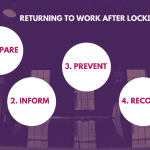Jon Abbott tells us how to deliver clear communication for a strong and robust health and safety program during times of crisis.
Communication for Returning to Work
In discussions I’ve had with key customers and with my health and safety colleagues, the complexity of the return to work process is a major challenge. It presents leaders of health and safety with a large number of strategic and operational difficulties.
And, the king of them all is communication.
Communication is our greatest challenge. If the message is wrong it creates confusion. In this crisis, that can lead to an increase in risk and the spread of infection.
What Makes a Good Message
Effective messaging delivers what you want to say in a way that’s easily understood. Your staff is bombarded with messages every day, from the Government, from advertisers, from colleagues, and as part of internal communication programs.
For those messages to stick, they need to be delivered simply, in easily understood language that provides practical results.
Think about all the successful messages you hear and immediately understand. What do they have in common? They use small words, short sentences, are clear, and provoke action. Messages like “See it, Say it, Sorted”, or “Stop, Look and Listen”. They provoke action and are simple enough to understand.
Contrast that with “Stay Alert, Control the Virus, Save Lives”. It’s unclear and doesn’t provoke action.
The 7 Cs of Communication
A familiar business framework for clear communication is the 7 Cs. This framework is useful to anyone delivering messages of any type but is particularly useful for internal communicators such as those in health and safety.
In all the best communications, you see they have a clear goal that is the key focus for the message. It is brief enough to attend only to the important points that really matter, and it uses simple, concrete language that gives the reader a clear picture.
Find out more about the 7Cs here.
- Clear
- Concise
- Concrete
- Correct
- Coherent
- Complete
- Courteous
How to Communicate Your Program Effectively in Health and Safety
My colleague, Hollie Smith, previously put together this article on effective ergonomics program communication, however, the core elements of it can be applied to all health and safety program communication.
Senior Leadership
Important corporate-level communications should come from the top. Directors should also be seen to be doing what is asked as well. This will reinforce action and behavior.
The Medium
There are many different mediums available, and ensuring the right content is on the right medium is vital. For example, posters and displays are brilliant at communicating simple messages; for something more complex choose e-learning or video-based learning.
The Message
Think about the message and the outcome you want. Compliance with rules ‘because you have to’ is a poor message to communicate to staff.
Instead, to achieve compliance, your message needs to be more considered and focus on the real challenges of returning to work.
These techniques are vital to ensure that communications at this time are considered and carefully delivered. With so much at stake, it’s important we get it right.
Want to communicate your return to work policy in a clear, concise, and concrete way? Our new e-learning course, Healthy Transitional Working, provides expert advice in a simple way to help you communicate your complex H&S messages.
For a free demo, email [email protected] now.






